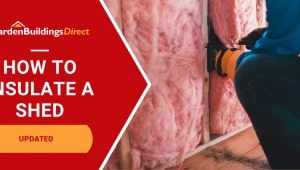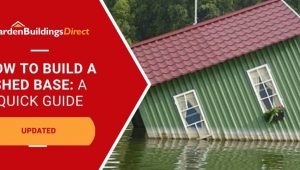Jump to:
Your garden shed takes a beating from weather, wear, and time. Looking after it is a bit of a chore, but it saves you from bigger problems later. Wooden, metal, or plastic—each type has its own needs, and you’ll find the steps you need here.
If you’re considering a new shed or want help deciding which type to buy, check out our comprehensive shed buying guide to compare materials, sizes, and features before making your choice.
Follow along to learn how to give your shed the care it deserves.
Wooden Shed Maintenance Guide
Wooden sheds can last a long time, but they need a little care along the way. Here’s what to keep an eye on:
Apply wooden shed treatment
Wood can rot or warp if it’s left unprotected. Treat your shed with a wood preservative or stain at least once a year, ideally in spring or early summer. Pressure-treated sheds still benefit from an extra coat, especially on exposed areas.
If you skip it, you might notice cracks or soft spots forming. Let’s not get to that point. Check out this guide to treat your wooden shed.
Inspect the roof
The roof takes most of the weather’s impact. Give it a once-over at least twice a year, such as after winter and at the end of summer, or whenever needed, e.g. after a storm.
Keep an eye out for any shingles or tiles that are loose, cracked, or missing, and fix them as necessary. Step inside and check for damp patches or signs of mould. If you spot any, a leak is likely forming. Repair the damaged roofing or seal any gaps before it gets worse!
Check the floor
Wooden floors are vulnerable to rot if water collects on them. Make it a habit to sweep out leaves, dirt, and any debris at least once a month. And if your shed has gutters or downpipes, confirm they’re clear and draining properly. Overlooked, and those blocked gutters might cause leaks that could damage the floorboards.
Metal Shed Maintenance
Metal sheds don’t need as much attention, but a few things can cause trouble if ignored. Here’s how to keep yours in good condition:
Protect the galvanised coating
Many metal sheds have a protective coating to prevent rust. Yet it wears off over time, especially around doors and corners. Check these areas regularly for scratches, dents, or bare metal. If you spot any, clean the surface and apply rust-resistant paint or a suitable primer to protect it.
If your shed isn’t coated, be aware of scratches or dents and aim to keep the metal dry. The same treatment mentioned above can be applied to any bare spots.
Read this guide for more maintenance tips: How to Stop a Metal Shed from Rusting
Look after the doors
Metal shed doors can bend, jam, or become hard to open. Oil the hinges and see that the doors close and sit flush with the frame. If you notice dents or loose screws, fix them straight away. Make sure the lock or latch works properly and isn’t sticking. Doing so makes using the door easier and avoids getting stuck.
Plastic Shed Maintenance
Plastic sheds are the easiest to look after, but a few steps will make them last longer:
Wash the shed
Plastic sheds don’t need much, but we recommend giving yours a good cleaning a couple of times a year. Try washing it in spring and again in late summer, using a hose and mild soap. Small cracks or any damage are easier to spot then.
Watch for cracks or warping
Plastic sheds can warp in hot weather or crack when it’s cold. Walk around and pay attention to any panels that feel uneven or have gaps. Small cracks can be sealed, while larger or warped panels may need replacing. Check the roof too; any bulges can let water collect and cause further damage.
We have more techniques for you to try here: Repair Guide for Cracks in a Plastic Shed
Clear the gutters and vents
If your shed has gutters or ventilation panels, make sure they don’t get blocked by leaves, dirt, or other debris. Take a look at them a few times a year, especially after storms or during autumn when leaves fall. Clear out anything that’s stopping water or air from moving freely.
Round-up
No matter what kind of shed you have, a little regular care makes a big difference. Wooden sheds need treatment and roof checks. Metal sheds require attention for rust and doors. Plastic sheds do best with a good cleaning and watching for cracks.
Spend some time each season on these tasks, and your garden storage will stay solid, dry, and ready to use for years!





